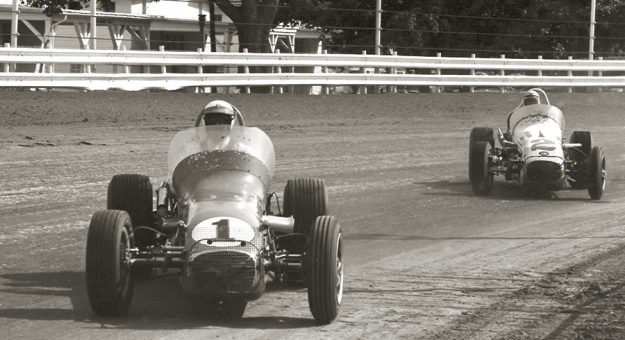“I tease Brian that the first time I went to Du Quoin they sent me out behind him during hot laps and he got to the other end so darn fast, but I followed him in there and promptly plugged the fence,” Swanson recalled. “That happened on the first lap. I thought, ‘I‘m not following anybody anymore.‘ I remember the first time I raced Springfield and he said, ‘you‘re going to have to lift three car lengths early maybe four.‘ I went out and thought I lifted too early, and I still missed the corner. They had given me a heads up. Our styles were similar, but there was enough that was different and that changed how we drove our cars. Still, he shared some of that general knowledge that is hard for a rookie to pick up. He was able to shorten the learning curve for me by a lot.”
Beyond the basics of driving these big cars there are important differences between the two Illinois miles.
“The way the infield wall is shaped changes them quite a bit,” explained Justin Grant. “With Du Quoin kind of being square on the infield you can‘t just lay in around the infield wall, and it doesn‘t get rubber laid in quite as thick as Springfield does. It opens up the options for lanes a little bit and it tends to race higher on the track than Springfield.

“At Du Quoin there is a little half-moon in the corner that stays dirty and dusty and if you are racing up front and you put pressure on a guy he will drop down and drag all of that dust out of that half-moon on you. Then if you slip you can miss the rubber and be out on the fence in turn two,” Grant added. “It‘s fun. There are lots of little games that get played and nuances that people don‘t pick up on.”
Tyler agreed.
“At Springfield you can run the guardrail pretty good, but at Du Quoin you almost have to diamond the corners,” Tyler said. “Du Quoin is shaped more like the Indianapolis Motor Speedway. It is like four separate corners with short chutes in between. If you run on the guardrail, you turn in then you go straight, and then turn again to get off the corner. I like Du Quoin better as a day show than a night show but that‘s just old school.”
Spotters are an added feature in Silver Crown racing. Any review of drivers will reveal that there is a wide range of preference on how much information they want their spotter to share. Many rely on other racers or their chief mechanic to fill the role, in Swanson‘s case he takes his guidance from his wife Jordan.
Grant admits that as an old sprint car guy he doesn‘t need a lot of talk, but said spotters can become a part of his race strategy.

“It adds a whole new element to the thing and it helps you pace the race,” Grant explained. “You can also use another driver‘s spotter to move them where you want them to go. If you want to circle them on the outside, you can start ducking low and their spotter will tell their driver you are looking low and you can drag them out of their lane. You can also tap a guy‘s bumper and the spotter says pressure, pressure and they guy will run harder and use his tires up. I sometimes use a guy‘s spotter against him more than I use my spotter to help me.”
Racing the miles is as much a mental exercise as it is a physical test. Start with a 75-gallon tail tank filled to the brim, and the car changes dramatically as the fuel burns away and tires deteriorate. That‘s what makes it an interesting enterprise.
“I always loved the miles,” Coons reflected. “What I liked about the miles and what makes them unique is that early in hot laps and qualifying at Du Quoin and at Springfield in the last couple of years because there has been a cushion, you can run flat out. Then in the actual race you are lifting at the flag stand, driving it in straight with all the fuel on board, and always trying to manage your tires.”
Grant, the reigning series champion, is even more animated regarding his love of Silver Crown racing.
“I don‘t think there is a cooler experience than hot lapping a Crown car at Springfield or Du Quoin when you are going wide open along the fence,” he said. “They are pretty gnarly. Then as the day goes on the rubber lays in and you get into dogfighting with other drivers. They are fun to race. They really are. They are every bit has high stakes as anything we do but they take a lot of thinking as well. You are constantly trying to manage the race, trying to manage your car and positioning yourself to make a run at the end.
“You aren‘t just riding around,” Grant continued. “You‘re going real fast. Sometimes the moves don‘t look as big for people who are used to seeing sprint cars go flying through the air, but you are making big moves. You are down there on the verge of locking the brakes up and trying to keep the thing in the rubber and not the dust. At those speeds if you miscalculate you are going to damage yourself and the guys you are racing with.”
Swanson, who has been the king of the series six times, feels that competing on a mile involves elements of dirt and pavement racing.
